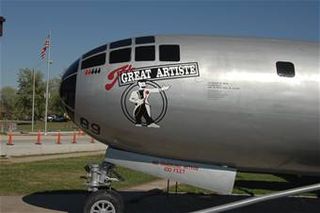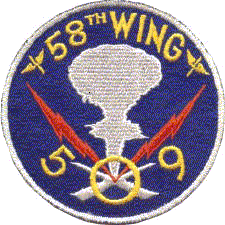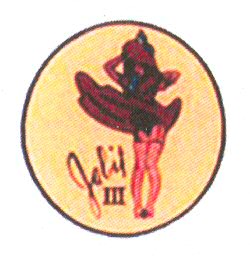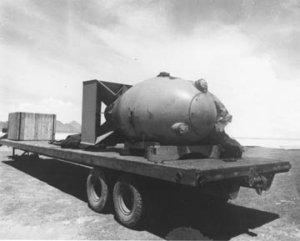This article relies largely or entirely on a single source .(March 2023) |
Up An' Atom was the name of a B-29 Superfortress (B-29-36-MO 44-27304, Victor number 88) configured during World War II in the Silverplate project to carry an atomic bomb.
This article relies largely or entirely on a single source .(March 2023) |
Up An' Atom was the name of a B-29 Superfortress (B-29-36-MO 44-27304, Victor number 88) configured during World War II in the Silverplate project to carry an atomic bomb.
Assigned to the 393d Bomb Squadron, 509th Composite Group, it was built at the Glenn L. Martin Aircraft Plant at Omaha, Nebraska, accepted by the Army Air Forces on April 3, 1945, and flown to Wendover Army Air Field, Utah, by its assigned crew B-10 (Capt. George W. Marquardt, Aircraft Commander). It departed Wendover for North Field, Tinian on June 11 and arrived on June 17.
It was originally assigned the Victor (unit-assigned identification number) number 8 but on August 1 was given the triangle N tail markings of the 444th Bomb Group as a security measure and had its Victor changed to 88 to avoid misidentification with actual 444th BG aircraft. It was named and had its nose art painted after the Nagasaki mission. The name is a word play on the colloquial idiom "Up and at 'em", meaning "There is a lot of work to be done," and referencing the unit's atomic mission.
While at Tinian, Marquadt and crew B-10 flew Up An' Atom on eight training and practice bombing missions and pumpkin bomb missions against industrial targets in Taira and Hamamatsu, Japan. Capt. Bob Lewis's crew B-9 flew it on a pumpkin bomb mission to Tokushima subsequent to the Hiroshima mission, and Lt.Col. James Hopkins and crew C-14 used it to attack Nagoya with a pumpkin bomb.
Up An' Atom returned to the United States with the 509th CG in November 1945 to Roswell Army Airfield. From April to August 1946 it was assigned to the Operation Crossroads task force. In August 1949 it became part of the 97th Bomb Group at Biggs Air Force Base, Texas, and was re-configured as a TB-29 trainer in April 1950 by the Oklahoma City Air Materiel Area at Tinker Air Force Base.
Its subsequent assignments were to:
Up An' Atom was dropped from the Air Force inventory in November 1956. It was transferred to the U.S. Navy and used as a target at the Naval Ordnance Test Station at China Lake, California.

The Great Artiste was a U.S. Army Air Forces Silverplate B-29 bomber, assigned to the 393d Bomb Squadron, 509th Composite Group. The aircraft was named for its bombardier, Captain Kermit Beahan, in reference to his bombing talents. It flew 12 training and practice missions in which it bombed Japanese-held Pacific islands and dropped pumpkin bombs on targets in Japan. It was the only aircraft to have participated in both the bombings of Hiroshima and Nagasaki, albeit as an observation aircraft on each mission.

Straight Flush was the name of a B-29 Superfortress that participated in the atomic bomb attack on Hiroshima on August 6, 1945.

Project Alberta, also known as Project A, was a section of the Manhattan Project which assisted in delivering the first nuclear weapons in the atomic bombing of Hiroshima and Nagasaki during World War II.

Wendover Air Force Base is a former United States Air Force base in Utah now known as Wendover Airport. During World War II, it was a training base for B-17 and B-24 bomber crews. It was the training site of the 509th Composite Group, the B-29 unit that carried out the atomic bombings of Hiroshima and Nagasaki.

The 509th Composite Group was a unit of the United States Army Air Forces created during World War II and tasked with the operational deployment of nuclear weapons. It conducted the atomic bombings of Hiroshima and Nagasaki, Japan, in August 1945.

Full House was the name of a B-29 Superfortress participating in the atomic bomb attack on Hiroshima on August 6, 1945.

Jabit III was the name of a B-29 Superfortress participating in the atomic bomb attack on Hiroshima on August 6, 1945. Assigned to the 393d Bomb Squadron, 509th Composite Group, Jabit III was used as a weather reconnaissance aircraft and flew to the city of Kokura, designated as the secondary target, before the final bombing to determine if conditions were favorable for an attack.
Necessary Evil, also referred to as Plane #91, was the name of Boeing B-29-45-MO Superfortress 44-86291, participating in the atomic bomb attack on Hiroshima on August 6, 1945.
Laggin' Dragon was the name of a Boeing B-29 Superfortress configured to carry the atomic bomb in World War II.

Big Stink – later renamed Dave's Dream – was a United States Army Air Forces Boeing B-29-40-MO Superfortress bomber that participated in the atomic bomb attack on Nagasaki, Japan on August 9, 1945. Assigned to the 393d Bomb Squadron, 509th Composite Group, it was used as a camera plane in support of the bomb-carrying B-29 Bockscar to photograph the explosion and effects of the bomb, and also to carry scientific observers. The mission was flown by crew C-14 but with Group Operations Officer Major James I. Hopkins, Jr., as the aircraft commander.

Silverplate was the code reference for the United States Army Air Forces' participation in the Manhattan Project during World War II. Originally the name for the aircraft modification project which enabled a B-29 Superfortress bomber to drop an atomic weapon, "Silverplate" eventually came to identify the training and operational aspects of the program as well. The original directive for the project had as its subject line "Silver Plated Project" but continued usage of the term shortened it to "Silverplate".
Some Punkins was the name of a B-29 Superfortress modified to carry an atomic bomb during World War II.

Pumpkin bombs were conventional aerial bombs developed by the Manhattan Project and used by the United States Army Air Forces against Japan during World War II. It was a close replication of the Fat Man plutonium bomb with the same ballistic and handling characteristics, but it used non-nuclear conventional high explosives. It was mainly used for testing and training purposes, which included combat missions flown with pumpkin bombs by the 509th Composite Group. The name "pumpkin bomb" was the term used in official documents from the large, fat ellipsoidal shape of the munition casing instead of the more usual cylindrical shape of other bombs, intended to enclose the Fat Man's spherical "physics package".
Next Objective was the name of a Boeing B-29-36-MO Superfortress, 44-27299, Victor 86, modified to carry the atomic bomb in World War II.

Top Secret was the name of a Boeing B-29 Superfortress modified to carry the atomic bomb in World War II. It served with the Army Air Forces and United States Air Force from 1945 until 1954.
Strange Cargo was the name of a B-29 Superfortress modified to carry the atomic bomb in World War II.
Luke the Spook was the name of a Boeing B-29-50-MO Superfortress configured to carry the atomic bomb in World War II.

Bockscar, sometimes called Bock's Car, is the name of the United States Army Air Forces B-29 bomber that dropped a Fat Man nuclear weapon over the Japanese city of Nagasaki during World War II in the second – and most recent – nuclear attack in history. One of 15 Silverplate B-29s used by the 509th, Bockscar was built at the Glenn L. Martin Aircraft Plant at Bellevue, Nebraska, at what is now Offutt Air Force Base, and delivered to the United States Army Air Forces on 19 March 1945. It was assigned to the 393rd Bombardment Squadron, 509th Composite Group to Wendover Army Air Field, Utah in April and was named after captain Frederick C. Bock.

The 320th Troop Carrier Squadron is an inactive United States Air Force unit. It was activated on 17 December 1944, and inactivated on 19 August 1946 at Roswell Army Air Field, New Mexico. The squadron was later consolidated with the 302d Transport Squadron and 302d Tactical Reconnaissance Squadron. The squadron was a support squadron for the 509th Composite Group during World War II. It was formed as the transport unit for the 509th, and due to the highly secret nature of the group, carried all supplies and equipment for Project Silverplate Atomic Bomb activities. It also functioned as a special air transport squadron for high-ranking officers, nuclear scientists and for the group's commander, Lt. Col. Paul Tibbets to meetings concerning Silverplate. The squadron later served as a transport squadron for atomic tests in the Marshall Islands in 1946.

The 216th Army Air Forces Base Unit (Special) provided base services at Wendover Army Airfield, where the 509th Composite Group was stationed during World War II. As such, it became involved in the Manhattan Project's program of testing bombs and aircraft under the codename Project W-47.